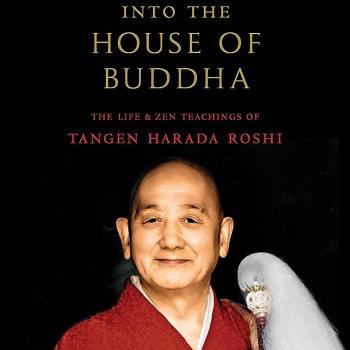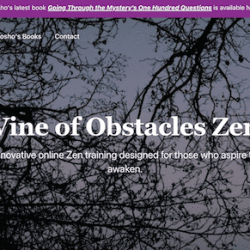I’m back from a camping trip, eh, up to Canada’s Sleeping Giant Provincial Park (which was wonderfully huge and beautiful) with a side trip to Kakabeka Falls, pictured here along with boy and dog. It warmed up and stopped raining so we’re not wearing wool sweaters and rain ponchos.
Last night at the Dogen study group picked up the Genjokoan again and began investigating the most difficult section on firewood and ash. A piece of which goes like this:
We should know that firewood dwells in the dharma position of firewood and its has it own before and after. Although there is before and after, past and future are cut off. Ash stays at the position of ash and it has its own before and after.
The main point here is about the whole works (as Cleary translates zenki with the intended multiple meanings – the whole works and the whole works), each thing vividly presenting in the fullness of subject and object without separation and even in separation that is included too.
It is important not to take the meaning of a passage like the above and be satisfied with a shallow understanding based on conditioning but to sit quietly and reflect on it again and again. Dogen often encourages this and it’s something that I’ve found to be a great practice. Not only does this practice have the power to keep our life alive and cooking for the long run but also educates our formations, the deep mental filters through which we see the world.
Not only should we avoid deciding that what we see is what we see, we should be firmly convinced that there is an essential message to be studied in all the 10,000 activities. We should know that, just as we may see the Buddha without knowing or understanding him, so we may see rivers and yet not know rivers, may see mountains and yet not know mountains. The precipitate assumption that the phenomena before one’s eyes offer no further passage is not Buddhist study.
So says Dogen in the Mountains and Rivers Sutra.
And here’s a recent email asking about the “how” of dharma study:
I have been spending my mornings re-reading your book. This morning in reading the chapter “Not Using Zazen,” I realized there was a point in time in my theistic journey that I finally said, “I just want to practice love where I am” and that should fulfill the whole of the law. Rendering down all the theology I had studied over the years to just this main point brought clarity to all that I struggled with in those years. As I read this chapter in your book I saw that same kind of thinking…do zazen and dharma reflection…no need to add anything to that to muddy the water. Can you elaborate on what you would call “dharma reflection?”
Zen is often presented as opposed to thinking. That’s what some people think. Based on my experience, I think that dharma thinking is one of the vital ingredients in transforming the heart and part of the full play of this life – thinking, not-thinking, nonthinking. Anyway, it is what’s happening in most people’s zazen and daily life at least some of the time so why feel guilty about it?
Of course, the activity of constantly letting go of thinking in zazen is also really important and that is what distinguishes dharma reflection from ordinary swirling in thought. Letting go of thinking characterizes mulling or rendering the dharma.
Middle English, from mul, mol dust, probably from Middle Dutch; akin to Old English melu -> meel -appointed time, meal, from Old English mæl; Latin metiri to measure … transitive verb 1 : to grind or mix thoroughly : pulverize 2 : to consider at length : ponder
The fire and ash passage quoted above provides direct instruction for zazen and life as well as wheat berries for the mill of dharma study to nourish a lifetime of study.











